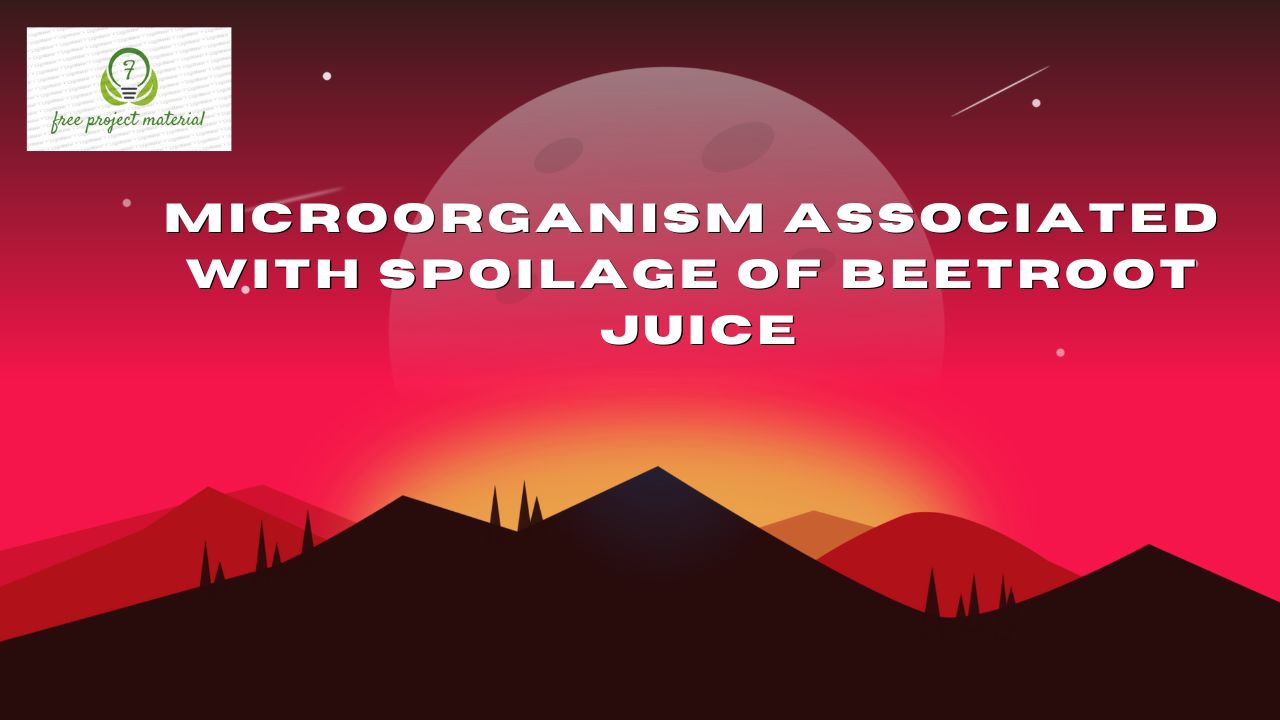ABSTRACT
Microorganisms associate with the spoilage of beetroot was carried out following all microbiological and biochemical standards. The results of the analysis reveals the presence of Corynebacterium sp (50.60%), Staphylococcus sp (26.03%), Enterobacter sp. (15.07) and Leuconostoc sp. (8.22%). The total bacterial count shows that the organisms range from 1.2×104 cfu/ml to about 2.3×104cfu/ml while the fungal isolate were Aspergillus sp (10%), Cladosporium sp (20%) and Penicillium sp (70%). This result reveal that beetroot juice can actually be exposed to contamination due to it nutritive content. The microbial presence in the spoilage of beetroot can be dangerous to the consumer therefore proper handling , processing and storage of the beetroot juice should be encourage by the health workers.
TABLE OF CONTENTS
Title Page- – – – – – – – – i
Certification- – – – – – – – ii
Dedication- – – – – – – – – iii
Acknowledgements- – – – – – – iv
Table of Contents- – – – – – – – v-vi
1.1 Background of the Study- – – – – – 1-4
1.2 Aim and Objectives of the Study- – – – – 4-5
1.3 Scope and Limitation of the Study- – – – – 5
CHAPTER TWO
LITERATURE REVIEW
2.1 Origin of Beetroot- – – – – – – 6-7
2.2 Harvesting and Handling of Beetroot- – – – – 8-10
2.3 Beetroot Processing and Product Formulation- – – 10-13
2.4 Health Benefit of Beetroot- – – – – – 13-15
2.5 Microorganism Involved in Spoilage of Fruit Juice- – 15-16
2.5.1 Yeasts- – – – – – – – – 16-17
2.5.2 Moulds- – – – – – – – – 18-19
2.5.3 Bacteria- – – – – – – – – 20-22
2.6 Isolation of Spoilage Microorganisms from Fruit Juice- – 22-24
2.7 Prevention of Spoilage and Pathogenic Microorganism
in Fruit Juice- – – – – – – – 24-27
CHAPTER THREE
MATERIALS AND METHOD
3.1 Materials- – – – – – – – – 28
3.2 Method- – – – – – – – – 28
3.2.1 Collection of Sample- – – – – – – 28
3.2.2 Preparation of Sample- – – – – – – 29
3.2.3 Sterilization of Equipment- – – – – – 29
3.2.4 Serial Dilution- – – – – – – – 30
3.2.5 Microbiological Analysis- – – – – – – 30
3.2.5.1 Cultivation of Microorganisms- – – – – 30-32
CHAPTER FOUR
RESULT AND DISCUSSION
4.1 Results- – – – – – – – – 33-35
4.2 Discussion- – – – – – – – – 36-37
CHAPTER FIVE
CONCLUSION AND RECOMMENDATION
5.1 Conclusion– – – – – – – – 38-39
5.2 Recommendation- – – – – – – – 39
References
CHAPTER ONE
INTRODUCTION
1.1 Background of the Study
Freshly expressed juice, is highly susceptible to spoilage, in fact more so than whole fruit. Unprotected by skin or cell walls, fluid components are thoroughly mixed with air and microorganisms from the environment. Thus, unhealed juice is subject to rapid microbial, enzymatic, chemical and physical deterioration.
The ubiquitous nature of microbes dictates that no matter how sanitary the raw material, juicing equipment and facilities are, the normal fruit microflora represents inevitable spoilage potential. The low pH of most juices favour yeast that rapidly initiates an incipient fermentation. Furthermore, the presence of aflatoxin producing mould contamination on the surface of fruits generally ends up in the juice.
In fact, until recently the uncontrolled fermentation of improperly handled low pH juice was wasteful, bit not deemed particularly dangerous. However, over the last decade fresh juice has increasingly been the source of serious food poisoning outbreaks and fatalities. Unpasteurized juice has been implicated in outbreak of Salmonella and merging pathogens such as E. coli.
There are several reasons for increased fresh juice food poisoning incidents
- Greater use of manure as fertilizer for fruit crops, a particular problem for organically grown produce.
- The pathogen are also becoming more robust and resistance to preservation techniques.
- The new media is also more efficient in detecting and publicizing food sanitation failures.
- Detection techniques base on molecular biology can now rapidly identify very low numbers and “fingerprint” specific pathogens or their metabolic products.
Another storage limiting factor affecting most juice is the common sugar-amines or maillard reaction. Reducing sugar and amines, ubiquitous to plant cells and hence juice, slowly go through a series of steps to form brown pigments in the baking of bread maillard products are responsible for the desirable crust colour and flavor, but not stop completely these undesirable reactions (Arroyo-lopez et al., 2012).
Chemical contamination can also occur from the environment. The unauthorized or excessive use of pesticide chemical is the most common and avoidable source, readily preventable by GAPs. Such contamination is particularly serious I organic juices where no pesticides are permitted. Even trace amounts of innocuous substances present in soil, water or wind drift can cause rejection. Although the health hazard is trivial, the analytical sensitivity insures detection. Mistakes anywhere in the food chain are more serious. Unlabeled white powder have been mistaken for food ingredient and added to juice, resulting in fatal poisoning.
The use of non-food grade equipment in the processing line is a relatively minor safety concern that still impacts juice quality. Metals such as copper, bronze, aluminium, iron, galvanized steel (except stainless) are easily attacked by fruit acids and in turn contribute metal ions to the juice. These ions can have pro-oxidant properties and adversely affect flavor, colour, clarity and nutritive value. In addition flexible connections are all food contacting surface should be stainless steel or food grade plastic, since off flavors and unauthorized plasticizers could leach into the juice. Certainly, contact with toxic metals such as lead, mercury, cadmium and zinc must be rigoriously avoided. Food grade surfaces are significantly less available and more expensive than easily obtained “hardware store” alternative, but much more durable, safe and ultimately cost-effective (Capazzi et al., 2012).
1.2 Aim and Objectives of the Study
The aim of the study is to assess the microorganism associated with the spoilage of beetroot juice.
The objectives of this study are;
- To examine the bacteria associated with the spoilage of beetroot juice
- To isolate and characterize the organisms in beetroot juice
- To enumerate the preventive measures for microbial spoilage of beetroot juice
- To make recommendation base on the result of the study.
1.3 Scope and Limitation of the Study
The study only covers the microbiological assessment of beetroot juice inly due to financial and time constraint.



